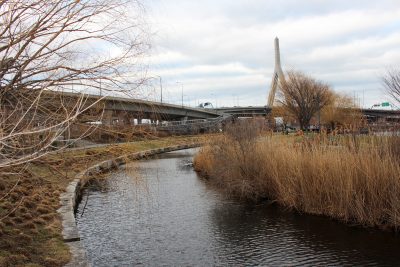
The Charles River Conservancy, a nonprofit that maintains and develops the parkland around the Charles River, has plans to design and open a swimming area at North Point Park and Splash Pad, according to SJ Port, the organization’s director of development and communications.
Port told The Daily Free Press the swim park is the latest development in the CRC’s long-running campaign to get swimmers back in the Charles River.
Port said the push to clean the Charles began in the 1990s as a result of the expansion of the Clean Water Act. Since then, people have started fishing and boating in the river again.
“The Conservancy was part of a commission to study whether the water of the Charles had reached a water quality level that was safe enough to return to boating and swimming,” Port said. “The only thing left to return is swimming.”
Port said although a feasibility report commissioned by the CRC after several successful swimming events determined the park could “potentially be feasible,” the project still faces safety challenges.
“We chose North Point Park because there a number of challenges left to swimming in the Charles,” Port said. “While we did stop polluting our rivers across country, only certain rivers were dredged.”
Port said the Charles has never been dredged, and is unlikely to be dredged anytime soon, so the toxic sediment remains.
Port emphasized the fact that the CRC has made efforts to prevent swimmers from disturbing the sediment, so that they are not exposed to the toxins present. The proposed park would include features leading swimmers into an area of the river that is deep enough to swim in without disturbing the toxins.
“North Point Park poses a great area where the dock leads into water that is deep enough that we could have a facility that has a base, that really does separate swimmers from that toxic sediment,” Port said.
The park would perform weekly water quality tests and would close temporarily whenever the tests indicated the river was unsafe, Port said.
The CRC held its first public listening session for the swim park on Saturday, where Port said they received a positive response from the public.
Port said the Boston Society of Architects Foundation, an organization that gave a small grant to the project, hosted the public forum.
Elliya Cutler, the program manager of civic initiatives at the BSA, wrote in an email to The Daily Free Press that the BSA Foundation was formed “to support public education programs in Massachusetts related to the built environment.”
“As the CRC is the recipient of a small grant, the BSA Foundation is happy to support programming related to the fulfillment of this grant,” Cutler wrote.
The organization is currently working on the park’s logistics, including the possibility of fees and memberships for those interested.
“There will be times when it’s free or a dollar to jump in, so that it’s accessible to everyone and anybody who wants to come and then you might be able to buy a membership if you want to be a lap swimmer or something like that,” Port said. “These are all to be determined coming up.”
As of yet, there is no set timeline for when the park will begin construction, Port said, although the CRC plans to open a competition for designers this fall.
“It all depends on how quickly we can fundraise and how quickly the permits get passed,” Port said.
As for the operation of the park, Port said the CRC plans to have it privately operated with a long-term lease from the state parks department.
Elisabeth Cianciola, an aquatic scientist at the Charles River Watershed Association, said scientists do not know the health consequences of coming into contact with the sediment.
“The sediments are definitely contaminated,” Cianciola said. “The question would really be sort of how much exposure people would get by swimming around those sediments.”
Cianciola said there are other unresolved safety issues, including E.coli and cyanobacteria contamination, which would require further studies and solutions before the Charles can be considered safe for swimming.
Several Boston residents said they looked forward to the possible development of a park on the Charles, although some expressed reservations about the safety of the water.
Christopher King, 25, of Allston, said the creation of a swim park could benefit Boston residents by providing an opportunity for more outdoor activities.
“I think that we have a lot of catching up to do when it comes to fun activities [compared to] other cities,” King said.
Tracy Simoneau, 55, of Jamaica Plain, on the other hand, said she knows the Charles has improved but is hesitant to actually go in because of existing issues.
“I probably personally wouldn’t swim [in the Charles],” Simoneau said.
Lindsey Wang, 27, of Brighton, said she would bring her child to the swim park, but only if it was deemed safe.
“It’s good place to have fun with people, with friends, with children, perhaps,” she said.

